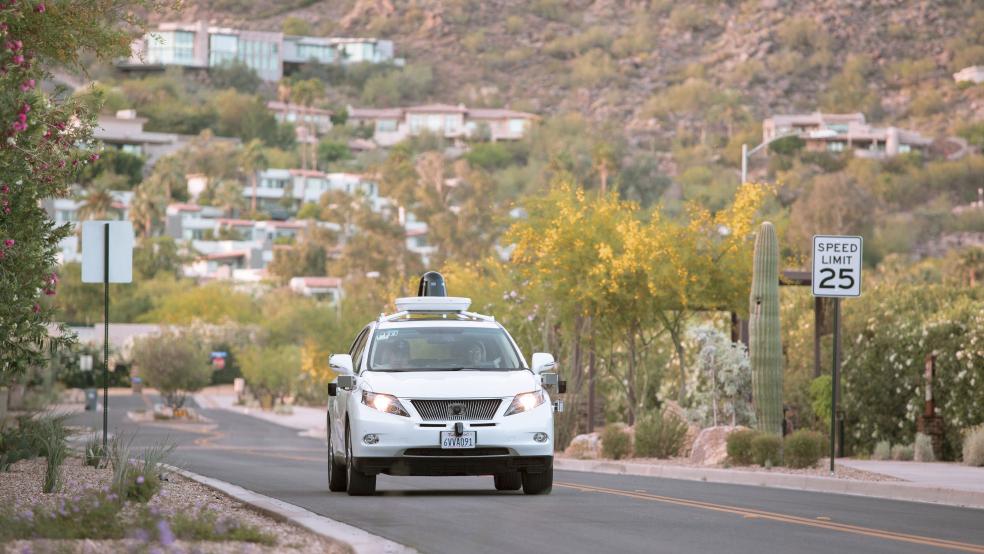Uber spent this holiday season trying to experiment on a large American city. Without permits from the California Department of Motor Vehicles, the company rolled out self-driving cars in San Francisco, albeit the kind that have a human pilot in the front seat just in case. The cars were almost immediately caught running red lights and stop signs and barely missing pedestrians, prompting the DMV and state Attorney General Kamala Harris to demand that they cease operations. Uber refused, citing an “important issue of principle.”
Days later, Uber acknowledged that the vehicles have a problem with unsafe turns across bike lanes, something they knew in pre-launch tests before placing the cars on roadways with lots of bikes, like in San Francisco. It must have been an important principle or something. Eventually, Uber bugged out of San Francisco after the DMV revoked registration on all its vehicles. But don’t weep for Uber: Arizona Gov. Doug Ducey welcomed them into the state for a pilot project in Phoenix.
Maybe concerns about beta-testing robotic steel projectiles alongside American citizens amount to mere griping. But it actually reveals a core conundrum with this whole self-driving car model. Most experts on autonomous vehicles believe that only real-world field tests, not simulations, will refine the technology so it can interact with often imperfect and irrational humans without killing them. Yes, ordinary humans kill 35,000 people a year while driving, but I suspect people will have far less tolerance for machine errors leading to similar levels of carnage. So who, besides the governor of Arizona apparently, would want to subject their citizens to being lab rats in this research?
Related: The 15 Best Cars of 2017
There’s only one way around this, and on rare occasions someone will let it slip. Vivek Wadhwa, a technology entrepreneur writing for The Washington Post, spun out a fantasy scenario last week of future commutes through Hyperloop vacuum tubes, with the last mile to the destination accomplished by self-driving cars. He gushed about how autonomous vehicles are already better equipped to handle traffic and could drive safely up to 200 mph “in their own partitioned lanes on highways.”
That’s right, the “disruption” of these vehicles would require the largest infrastructure project in the history of mankind. And Wadhwa knows it: He counsels a “wise investment” in reserving lanes for self-driving cars over alternatives like high-speed rail.
Related: The Smartest Way to Finally Fix America’s Crumbling Infrastructure
How wise would this investment be? Imagine the Eisenhower-era construction of the interstate highway system. Now add every state thruway and turnpike, as well as local boulevards and avenues, if you want the cars to reach a final destination. Every one of those roads would need a new dedicated lane, according to Wadhwa.
Even without adding or partitioning millions of lanes, you would need to significantly upgrade U.S. roads to optimize all of them for self-driving autos. “You need to paint the bloody roads here!” Volvo North America CEO Lex Kerssemakers famously shouted to Los Angeles Mayor Eric Garcetti when one of the carmaker’s autonomous vehicles refused to move forward during a high-profile test at a recent auto show. There are 3 million miles of roads in the U.S., and a majority of them are in poor condition. Fixing that would require re-striping every lane in America, or fitting the blacktop with sensors.
Maybe better auto technology can reduce the need to redo all American roads. Or maybe you can just have a human driver take over the tricky stuff, at which point you don’t have an autonomous vehicle. But instead of investing in stronger mapping or sensory technology, the companies making self-driving cars would rather the government pay to upgrade roads. And just think of the cost of such an enterprise: Donald Trump’s alleged trillion-dollar infrastructure program wouldn’t come close to getting it all done.
Related: Who’s Going to Pay for Trump’s Huge Infrastructure Plans?
I think normal people would call what we have here a grift. The car companies want to commandeer public infrastructure as a massive subsidy for their business model. And in the zero-sum world of government spending, such a scheme necessarily crowds out transportation that everyone can afford to use. We’re already seeing cities cut mass transit spending in favor of giving people coupons for Uber or Lyft. Considering that these companies aren’t making money and will eventually have to cash in on their oligopoly with higher rates, this kind of trade-off will eventually price poorer Americans out of getting where they need to go.
All the optimistic takes on America’s robot-led future make the same mistake of assuming that the whole country starts out on the same level of built infrastructure. Looking at the election results will tell you we have a wide disparity of regional inequality. That makes these best-laid plans impossible without a bigger public investment than ever conceived before, to the benefit of corporate executives.
This nullifies the other dream Silicon Valley tech types tout to accompany the robot-driven economy: the universal basic income. The theory goes that in the future, humans will have nothing to do, so we must give everyone a small stipend to keep them out of poverty. I question the idea that automation definitively reduces jobs rather than creating them. However, freeing people up with a basic safety net could jump-start entrepreneurship and allow people to pursue their dreams; it doesn’t have to just be a substitute for work.
Related: Could a Universal Basic Income Really Work?
The problem is that this dream never reconciles with the multi-trillion-dollar investment necessary to reach that supposed future. Somebody will have to build those new lanes and re-stripe all those roads. Somebody will have to string wires on poles or burrow them underground to reach every remote section of the country with broadband. Somebody will have to generate the energy that will help all this new infrastructure run. And these jobs should pay well, too.
The interstate highway system took about 35 years to complete. We have at least as much work ahead of us if we really want to invest in the future. And we may decide that expending enormous public sums for the benefit of a handful of companies doesn’t make a ton of sense, in which case we’ll still need all those truck drivers and chauffeurs a little longer. This argues for a job guarantee, which would channel public energies into these investments, rather than a basic income concept that seems way too premature.
I know in the Trump era, arguing about how best to handle future days of unending human leisure can sound a bit irrelevant. But if the new administration accelerates the trend of handing over public resources to private interests, you can bet Uber will be first in line. Our eyes should be open: The glorious Jetsons-style vision propounded by Silicon Valley companies comes with the twist of indirectly siphoning trillions of public dollars into their coffers.






